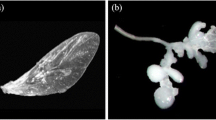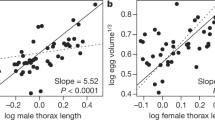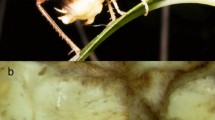Abstract
A comprehensive understanding of sexual selection requires knowledge of the traits and mechanisms responsible for increasing a male’s paternity share (proportion of progeny sired) relative to that of other males mating with the same female. In this study we manipulated by starvation the expression of traits that might influence male paternity share in Tribolium castaneum. We then conducted experiments to examine how male starvation affects male performance during sequential episodes of sexual selection from mating to progeny production, and investigated female control over specific stages by using live vs dead females. Comparison of starved vs fed males revealed that T. castaneum females have control over spermatophore transfer during mating, as live females rejected inseminations by starved (“low quality”) males. None of the measured male copulatory behaviors (leg-rubbing frequency, asymmetry, and percent of time spent rubbing) affected the probability of successful insemination, but the last two were positively associated with male paternity share. Spermatophore positioning within the female reproductive tract was not affected by male treatment (starved/fed), by female treatment (live/dead), or by male copulatory behaviors. Starvation, however, had a dramatic effect on male reproductive physiology, decreasing both accessory gland size and total number of sperms transferred (but not sperm viability in seminal vesicles). In addition, females who mated to starved males stored fewer sperms in their spermathecae, which, together with decreased ejaculate size, may explain the reduced paternity share of starved males compared to fed males. This study elucidates some cryptic mechanisms influencing male reproductive success and aids our understanding of trait evolution through sexual selection.




Similar content being viewed by others
References
Andersson M (1994) Sexual selection. Princeton University Press, Princeton
Basolo AL (1998) Shift in investment between sexually selected traits: tarnishing of the silver spoon. Anim Behav 55(3):665–671
Birkhead TR, Möller AP (1998) Sperm competition and sexual selection. San Diego, CA: Academic Press
Bloch Qazi MC (2003) A potential mechanism for cryptic female choice in a flour beetle. J Evol Biol 16:170–176
Bloch Qazi MC, Herbeck JT, Lewis SM (1996) Mechanisms of sperm transfer and storage in the red flour beetle (Coleoptera: Tenebrionidae). Ann Entomol Soc Am 89:892–897
Bloch Qazi MC, Aprille JR, Lewis SM (1998) Female role in sperm storage in the red flour beetle, Tribolium castaneum. Comp Biochem Physiol A 120:641–647
Bonduriansky R, Rowe L (2005) Sexual selection, genetic architecture, and the condition dependence of body shape in the sexually dimorphic fly Prochyliza xanthostoma (Piophilidae). Evolution 59(1):138–151
Brandt LSE, Greenfield MD (2004) Condition-dependent traits and the capture of genetic variance in male advertisement song. J Evol Biol 17(4):821–828
Cordoba-Aguilar A (1999) Male copulatory sensory stimulation induces female ejection of rival sperm in a damselfly. Proc R Soc Lond B 266(1421):779–784
Cotton S, Fowler K, Pomiankowski A (2004) Heightened condition dependence is not a general feature of male eyespan in stalk-eyed flies (Diptera: Diopsidae). J Evol Biol 17(6):1310–1316
Droney DC (1998) The influence of the nutritional content of the adult male diet on testis mass, body condition and courtship vigor in a Hawaiian Drosophila. Funct Ecol 12(6):920–928
Eberhard WG (1996) Female control: sexual selection by cryptic female choice. Princeton University Press, Princeton
Edvardsson M, Arnqvist G (2000) Copulatory courtship and cryptic female choice in red flour beetles Tribolium castaneum. Proc R Soc Lond B 267:559–563
Emlen DJ (1997) Diet alters male horn allometry in the beetle Onthophagus acuminatus (Coleoptera: Scarabeidae). Proc R Soc Lond B 264(1318):567–574
Faustini DL, Burkholder WE, Laub RJ (1981) Sexually dimorphic setiferous patch in the male red flour beetle, Tribolium castaneum (Hbst.) (Coleoptera: Tenebrionidae): site of aggregation pheromone production. J Chem Ecol 7:456–479
Fedina TYu, Lewis SM (2004) Female influence over offspring paternity in the red flour beetle Tribolium castaneum. Proc R Soc Lond B 271:1393–1399
Fry CL, Wilkinson GS (2004) Sperm survival in female stalk-eyed flies depends on seminal fluid and meiotic drive. Evolution 58(7):1622–1626
Gadzama NM, Happ GM (1974) The structure and evacuation of the spermatophore of Tenebrio molitor L. (Coleoptera: Tenebrionidae). Tissue Cell 6(1):95–108
Hussain A (1994) Chemical ecology of Tribolium castaneum Herbst (Coleoptera: Tenebrionidae): factors affecting biology and application of pheromone. Ph.D. thesis, Oregon State University
Hunt J, Bussière LF, Jennions MD, Brooks R (2004) What is genetic quality? Trends Ecol Evol 19(6):329–333
Kotiaho JS (2000) Testing the assumptions of conditional handicap theory: costs and condition dependence of a sexually selected trait. Behav Ecol Sociobiol 48:188–194
Kotiaho JS, Simmons LW, Tomkins JL (2001) Towards resolution of the lex paradox. Nature 410(6829):684–686
Lewis SM, Austad SN (1990) Sources of intraspecific variation in sperm precedence in red flour beetles. Am Nat 135:351–359
Lewis SM, Austad SN (1994) Sexual selection in flour beetles: the relationship between sperm precedence and male olfactory attractiveness. Behav Ecol 5:219–224
Nilsson T, Fricke C, Arnqvist G (2003) The effects of male and female genotype on variance in male fertilization success in the red flour beetle (Tribolium castaneum). Behav Ecol Sociobiol 53:227–233
Pai A, Yan G (2002) Female mate choice in relation to heterozygosity in Tribolium castaneum. J Evol Biol 15:1076–1082
Pai A, Yan G (2003) Rapid female multiple mating in red flour beetles (Tribolium castaneum). Can J Zool 81(5):888–896
Parker GA (1970) Sperm competition and its evolutionary consequences in the insects. Biol Rev 45:525–567
Price CSC, Kim CH, Posluszny J, Coyne JA (2000) Mechanisms of conspecific sperm precedence in Drosophila. Evolution 54(6):2028–2037
Rantala MJ, Kortet R, Kotiaho JS, Vainikka A, Suhonen J (2003) Condition dependence of pheromones and immune function in the grain beetle Tenebrio molitor. Funct Ecol 17(4):534–540
Roberts MM, Grimnes KA (1994) Histological evidence for five cell types in the male accessory reproductive glands of Tribolium freemani (Coleoptera: Tenebrionidae). Tribolium Inf Bull 34:72–74
Rowe L, Houle D (1996) The lek paradox and the capture of genetic variance by condition dependent traits. Proc R Soc Lond B 263(1375):1415–1421
Scheuber H, Jacot A, Brinkhof MWG (2004) Female preference for multiple condition-dependent components of a sexually selected signal. Proc R Soc Lond B 271(1556):2453–2457
Simmons LW (2001) Sperm competition and its evolutionary consequences in the insects. Princeton University Press, Princeton
Simmons LW, Kotiaho JS (2002) Evolution of ejaculates: patterns of phenotypic and genotypic variation and condition dependence in sperm competition traits. Evolution 56(8):1622–1631
Smith RL (1984) Sperm competition and the evolution of animal mating systems. New York: Academic Press
Snook RR, Hosken DJ (2004) Sperm death and dumping in Drosophila. Nature (Lond) 428(6986):939–941
Sokoloff A (1974) The biology of Tribolium, v II. Oxford University Press, London, UK
Sokoloff A, Slatis HM, Stanley J (1960) The black mutation in Tribolium castaneum. J Hered 52:131–135
Tallamy DW, Darlington MB, Pesek JP, Powell BE (2003) Copulatory courtship signals male genetic quality in cucumber beetles. Proc R Soc Lond B 270:77–82
Tomkins JL, Radwan J, Kotiaho JS, Tregenza T (2004) Genic capture and resolving the lek paradox. Trends Ecol Evol 19(6):323–328
Ward PI (1993) Females influence sperm storage and use in the yellow dung fly Scathophaga stercoraria (L). Behav Ecol Sociobiol 32(5):313–319
Ward PI, Simmons LW (1991) Copula duration and testes size in the yellow dung fly Scathophaga stercoraria L. The effects of diet, body size and mating history. Behav Ecol Sociobiol 29(2):77–86
Wilson N, Tubman SC, Eady PE, Robertson GW (1997) Female genotype affects male success in sperm competition. Proc R Soc Lond B 264:1491–1495
Wolfner MF (2002) The gifts that keep on giving: physiological functions and evolutionary dynamics of male seminal proteins in Drosophila. Heredity 88(2):85–93
Yan G, Stevens L (1995) Selection by parasites on components of fitness in Tribolium beetles: the effect of intraspecific competition. Am Nat 146(5):795–813
Acknowledgements
We thank Dr. Durwood Marshall for statistical advice; Dr. Margaret Bloch Qazi, Randi Rotjan, and three anonymous reviewers for helpful comments on the manuscript; and Tufts University Graduate Research Award for financial support. These experiments complied with all current US laws.
Author information
Authors and Affiliations
Corresponding author
Additional information
Communicated by M. Siva-Jothy
Rights and permissions
About this article
Cite this article
Fedina, T.Y., Lewis, S.M. Proximal traits and mechanisms for biasing paternity in the red flour beetle Tribolium castaneum (Coleoptera: Tenebrionidae). Behav Ecol Sociobiol 60, 844–853 (2006). https://doi.org/10.1007/s00265-006-0228-7
Received:
Revised:
Accepted:
Published:
Issue Date:
DOI: https://doi.org/10.1007/s00265-006-0228-7




